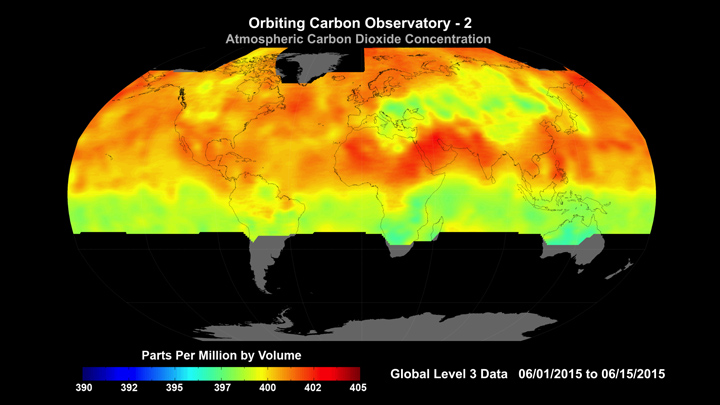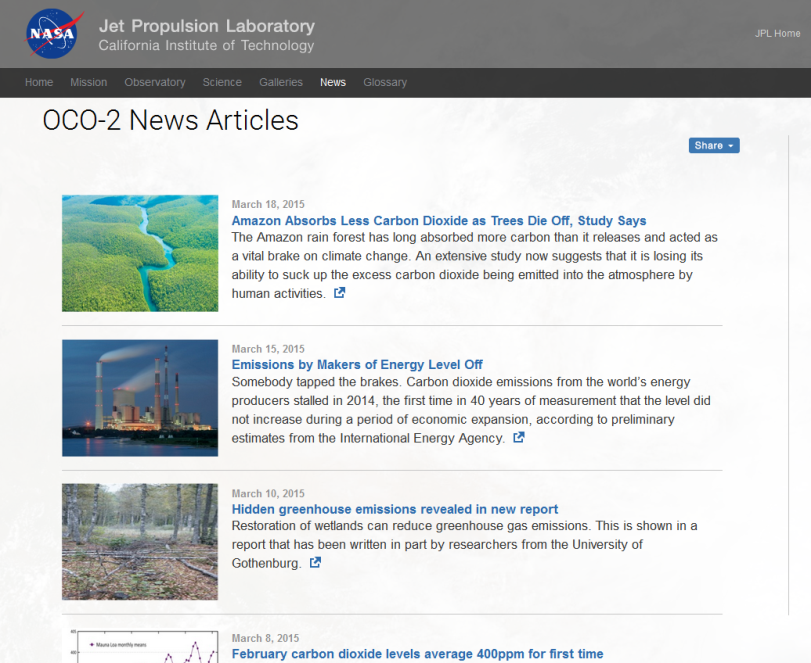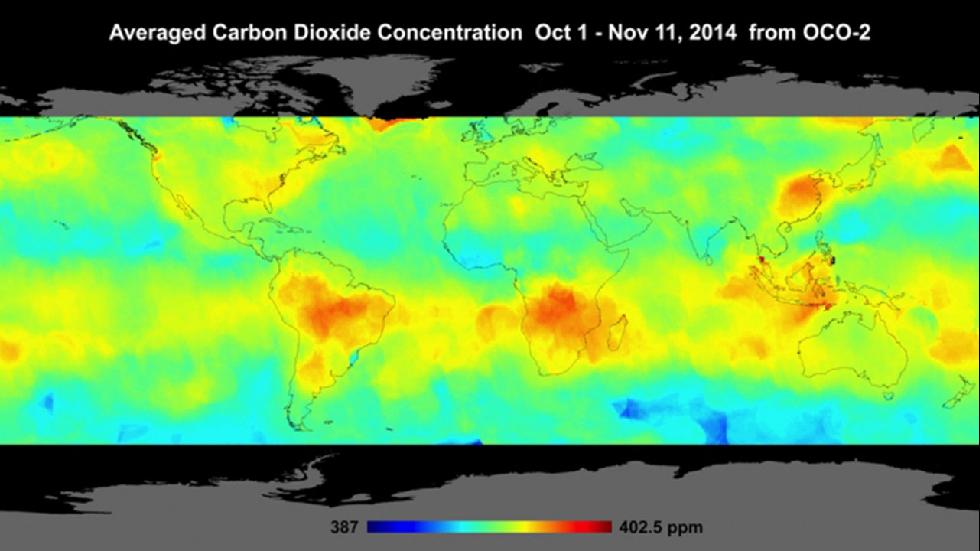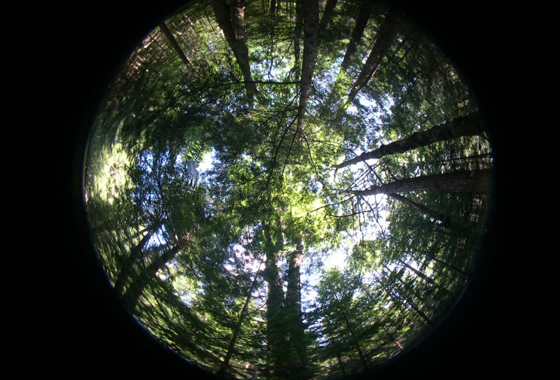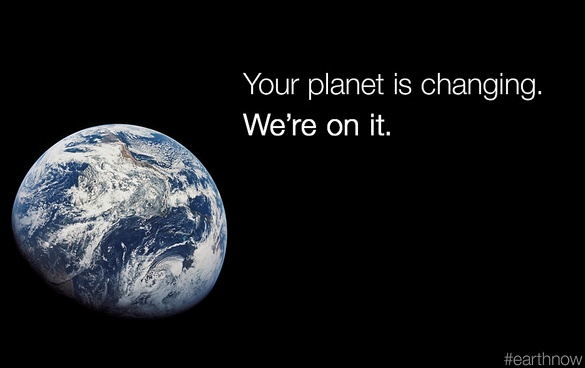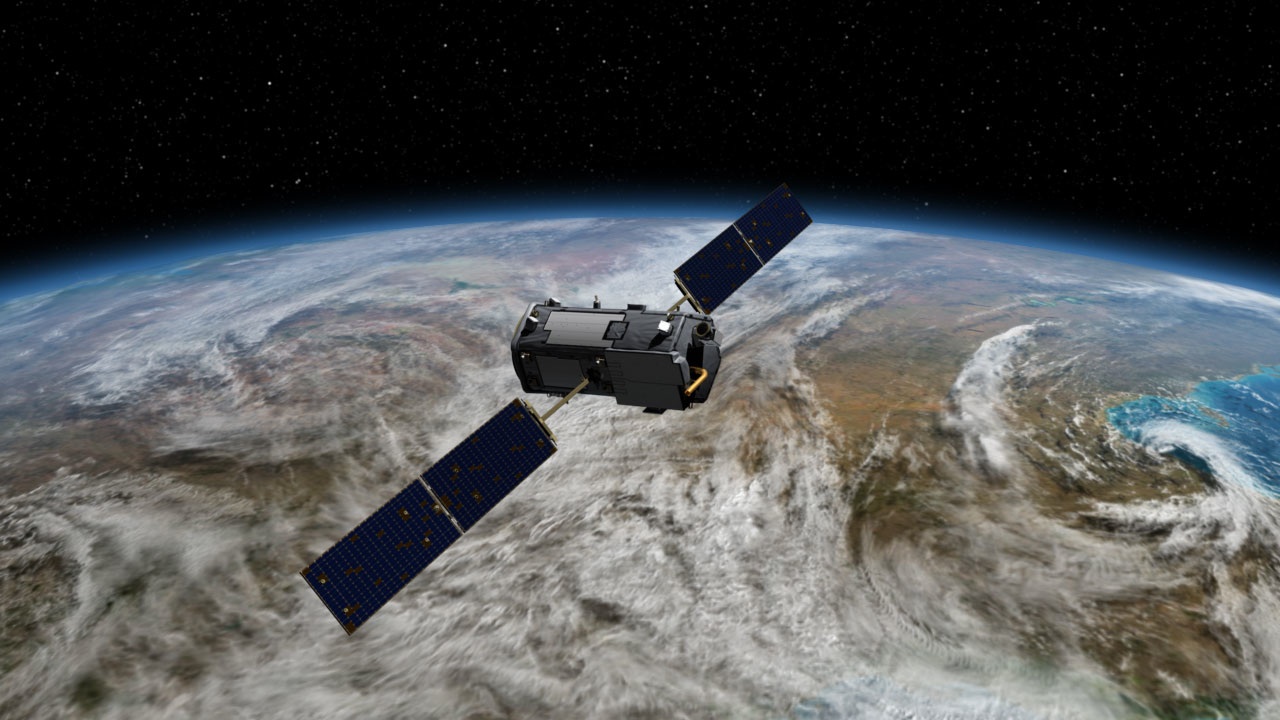OCO-2
Atmospheric Science
- OCO-2 / Orbiting Carbon Observatory Mission
I am OCO-2 -- reporting home Climate deniers blame global warming on nature. This NASA data begs to differ
Earth atmosphere emission data begins to be made available -- Sept 2015
CO2 Virtual Science Data Environment / GOSAT --- AQUA --- OCO-2 --- http://tccon.ornl.gov/
New Definitions of National Security
○ ○ ○ ○
2015
Mission Reports
The Orbiting Carbon Observatory (OCO-2) team refines mission... OCO-2 will orbit closer to CloudSat and CALIPSO in the Afternoon "A-Train" of Earth-circling satellites.
OCO-2 research team changes of OCO-2 orbit to enable pairing up one million daily measurements of carbon dioxide made by OCO-2 with cloud and aerosol measurements made by the other A-Train satellites.
Instrument calibration and data reprocessing updates result in improved visualizations of how carbon is moving around the planet, as baseline data is gathered and studied.
"Planet citizens/planet scientists" can now enter and utilize the Earth Observation open access database.
-=-=-=-=-=-=-=-=-=-=-=-
March/April 2015
http://www.nasa.gov/mission_pages/oco2/index.html
-=-=-=-=-=-=-=-=-=-=-=-=-=-=-=-=-=-=-=-=-=-=-=-=-=-=-=-=-=-=-=-=-=-=-=-=-=-=-=-=-=-=-=-=-=-=-=-=-=-=-=-=-=-=-=-=-=-=-=-=-=
February 2015
December 2014
Historic Orbiting Carbon Observatory Satellite Sends Back Most Detailed CO2 View Ever / Dec 18, 2014
The 'Initial Level 1 round' of data was made available to the public on Dec 30, 2014.
A full Level 2 set of CO2 data is scheduled to be available in March for scientists and the public "planet citizens" to download and explore.
Phys.org - Discovery - Weather - Nature
○
November
Counting carbon over Southern California - OCO-2 at work
October
September
August
August 13th/Climate Central news report of first data
July 2 2014
NASA Launches New Carbon-Sensing Mission to Monitor Earth’s Breathing
"Climate change is the challenge of our generation," says NASA Administrator Charles Bolden.
Follow the tweets of the OCO-2 bird
OCO-2, a "game changer"... Follow the NASA climate blog
"Game changing" science Unraveling mysteries
_______________________________________________________________________________
Observing Global Warming with #OCO-2
Historic launch #PlanetCitizen mission to study #EarthsAtmosphere
"First Light!" [1] [2] OCO-2 announces 'We have data!'
OCO-2 tweets - https://twitter.com/IamOCO2
What monitoring a potential existential crisis looks like...spectra from #OCO-2 #Earth360
Earth observing satellites, Orbiting Carbon Observatory the "Afternoon Constellation", the "A-Train" joined by #OCO-2 newly launched and historic in its mission to study global warming
"Watching the Earth Breathe from Space" [3] [4] [5] [6]
About the Earth Observatory Mission
○ ○ ○ ○
https://oco.jpl.nasa.gov/mission/quickfacts/
The OCO-2 Project primary science objective is to collect the first space-based measurements of atmospheric carbon dioxide with the precision, resolution and coverage needed to characterize its sources and sinks and quantify their variability over the seasonal cycle. During its two-year mission, OCO-2 will fly in a sun-synchronous, near-polar orbit with a group of Earth-orbiting satellites with synergistic science objectives whose ascending node crosses the equator near 13:30 hours Mean Local Time (MLT). Near-global coverage of the sunlit portion of Earth is provided in this orbit over a 16-day (233-revolution) repeat cycle. OCO-2’s single instrument incorporates three high-resolution grating spectrometers, designed to measure the near-infrared absorption of reflected sunlight by carbon dioxide and molecular oxygen.
Further objectives include:
- Retrieve estimates of the column-averaged carbon dioxide dry air mole fraction (XCO2) on regional scales (1,000 kilometers or greater) from space-based measurements of the absorption of reflected sunlight by atmospheric carbon dioxide and oxygen, collected in cloud-free scenes at least 80 percent of the range of latitudes on the sunlit hemisphere at monthly intervals for two years.
- Compare space-based and ground-based XCO2 retrievals from soundings collected during overflights of three or more primary ground validation sites at least once each season to identify and correct global-scale systematic biases in the space-based XCO2 product and to demonstrate a precision of 0.3 percent or less for collections of 100 or more cloud-free soundings.
- Record, validate, publish and deliver science data records and calibrated geophysical data products to the Goddard Earth Sciences Data and Information Services Center for use by the scientific community.
- Validate a space-based measurement approach and analysis concept that could be used for future systematic carbon dioxide monitoring missions.
The main points for the mission are:
Message One: The burning of fossil fuels and other human activities are currently adding more than 36 billion tons of carbon dioxide to the atmosphere each year, producing an unprecedented buildup in this important greenhouse gas. OCO-2 provides a new tool for understanding the sources of carbon dioxide emissions and how they are changing over time.
Message Two: Less than half of the carbon dioxide emitted into the atmosphere by human activities stays there. The location and identity of the natural “sinks” that are absorbing the rest of this carbon dioxide are currently not well understood. OCO-2 will help solve this critical scientific puzzle.
Sub-message: Knowing what parts of Earth are helping remove carbon from the atmosphere will help us understand if they will keep doing so in the future. OCO-2 measurements will help scientists construct better models to predict how much carbon dioxide these sinks will be able to absorb in the future.
Message Three: The innovative technologies incorporated into OCO-2 will enable space-based measurements of carbon dioxide with the sensitivity, resolution and coverage needed to understand human and natural sources of carbon dioxide emissions and the natural sinks that control its buildup, at regional scales, everywhere on Earth. Sub-message: To control carbon dioxide in our atmosphere, we need to be able to measure it. We can only manage what we can measure.
Message Four: OCO-2 will help assess the usefulness of space-based measurements of carbon dioxide for managing emissions of this important greenhouse gas.
_______________________________________________________________________________
With launch of OCO-2, a "game changer", #Earth360 science will grow in unprecedented ways
#Earthdata enables informed decisions and policy
"You can manage only what you can measure"
_______________________________________________________________________________
#EarthScience data is coming in and being openly distributed
Be a Planet Citizen, a Citizen Scientist
Use your digital tools as a Planet Scientist and Citizen
Take up the challenge with NEX and #OpenSource and #PlanetAPI ventures available for the first time
NASA NEX Earth Sciences Asks the Public to Join In
Add your #PlanetCitizen talent to a future of seeing with an #EarthPOV
_______________________________________________________________________________
- Atmospheric Science
- Anthropocene
- Atmosphere
- Ecology Studies
- EOS eco Operating System
- Sustainability
- Sustainability Policies
- Biosphere
- Digital Citizen
- Earth360
- Earth Observations
- Earth Science
- Eco-nomics
- Environmental Full-cost Accounting
- Environmental Security
- Environmental Security, National Security
- Global Security
- Global Warming
- NASA
- National Security
- New Space
- Planet Citizen
- Planet Scientist
- Planet Citizens, Planet Scientists
- Planet API
- Strategic Demands
- Whole Earth
- Climate Change
- Climate Policy
- Arctic
- Cryosphere
- Geophysics and Geochemistry
- Geophysics
- Hydrology
- Natural Resources
- Ocean Science
- Planetary Science
- Space Science and Space Physics


